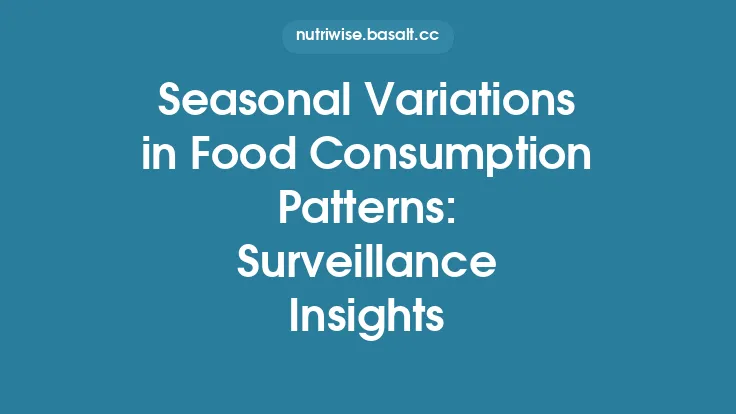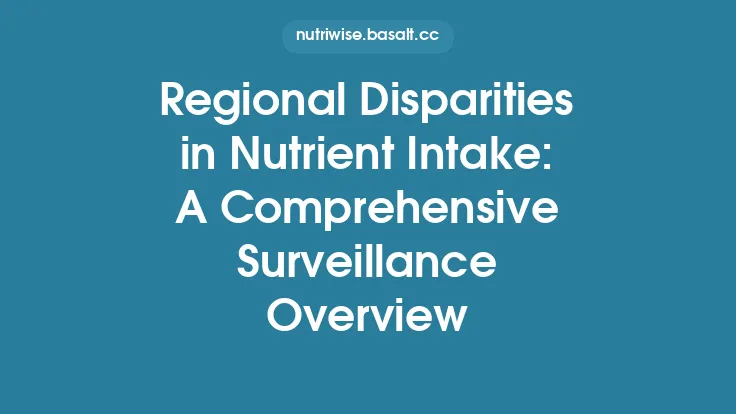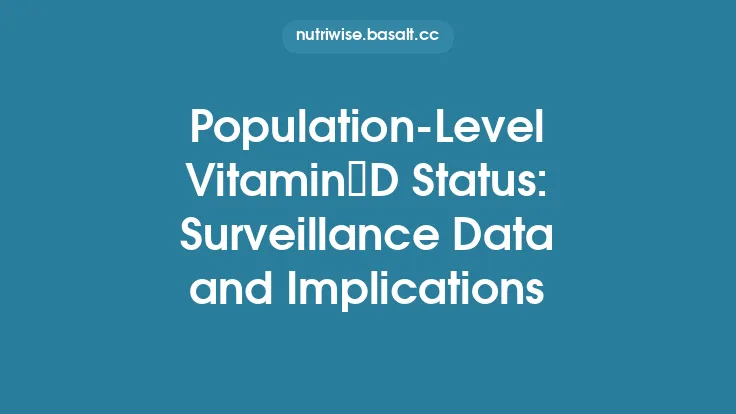Food frequency questionnaires (FFQs) have become a cornerstone tool for capturing habitual dietary intake in population‑level nutrition surveillance. Their capacity to gather information on a wide array of foods and nutrients from thousands of respondents makes them especially valuable for large‑scale monitoring programs that aim to track dietary patterns over time, inform public‑health policy, and evaluate the impact of nutrition interventions. This article provides a comprehensive, evergreen guide to the design, implementation, analysis, and interpretation of FFQs within the context of large‑scale nutrition surveillance, highlighting best practices, methodological considerations, and emerging innovations.
1. Foundations of the Food Frequency Questionnaire
1.1 Definition and Core Principle
An FFQ is a self‑report instrument that asks respondents to indicate how often, over a specified reference period (typically the past month or year), they consume a list of foods and beverages. Frequency responses are usually captured on a categorical scale (e.g., “never,” “once per month,” “2–4 times per week,” “daily”) and are later combined with standard portion‑size estimates to derive quantitative intake data.
1.2 Types of FFQs
- Semi‑quantitative FFQ – includes frequency categories plus a standard portion size, allowing estimation of absolute nutrient intakes.
- Qualitative FFQ – records only frequency, useful for ranking individuals but not for precise intake calculations.
- Short‑form FFQ – a reduced list of foods targeting specific nutrients or food groups; advantageous when respondent burden must be minimized.
- Comprehensive FFQ – extensive food lists (often >150 items) designed to capture the full dietary spectrum of a population.
1.3 Why FFQs Suit Large‑Scale Surveillance
- Low respondent burden compared with multiple 24‑hour recalls or weighed food records.
- Cost‑effectiveness: one questionnaire can be administered to thousands of participants with minimal staff time.
- Feasibility for remote or mail‑based data collection, enabling coverage of geographically dispersed populations.
- Ability to assess usual intake, which is essential for linking diet to chronic disease risk and for monitoring long‑term trends.
2. Designing an FFQ for Population Surveillance
2.1 Defining the Surveillance Objectives
Clear objectives guide every design decision. Common surveillance goals include:
- Estimating average intake of macronutrients and key micronutrients.
- Monitoring consumption of specific food groups (e.g., fruits, vegetables, processed meats).
- Detecting shifts in dietary patterns over time.
2.2 Selecting Food Items
- Representativeness: Include foods that contribute substantially to the nutrients of interest in the target population.
- Cultural relevance: Ensure the list reflects regional cuisines, preparation methods, and commonly consumed items.
- Variability: Prioritize foods with high inter‑individual consumption variability, as they provide the most discriminative power.
2.3 Structuring Frequency Categories
- Use a balanced set of categories that capture low, moderate, and high consumption without overwhelming respondents.
- Typical scales: “Never,” “<1 per month,” “1–3 per month,” “1–3 per week,” “4–6 per week,” “1 per day,” “≥2 per day.”
- Provide clear definitions (e.g., “1 per day” = one serving each day) to reduce misinterpretation.
2.4 Portion‑Size Estimation
- Standardized portion sizes: Adopt portion sizes derived from national dietary surveys or validated portion‑size databases.
- Visual aids: Include photographs, line drawings, or household‑measure equivalents (e.g., “1 cup,” “1 tablespoon”) to improve accuracy.
- Optional portion‑size questions: For nutrients with high variability (e.g., fats, sugars), ask respondents to select a typical portion from a small set of options.
2.5 Pilot Testing and Cognitive Interviewing
- Conduct small‑scale pilots (n ≈ 30–50) to assess comprehension, recall difficulty, and time to complete.
- Use cognitive interviewing techniques to uncover misunderstandings and refine wording.
- Iterate until the questionnaire demonstrates acceptable clarity and completion time (generally ≤20 minutes).
3. Validation and Calibration
3.1 Importance of Validation
Even well‑designed FFQs can suffer from systematic bias. Validation against a reference method (e.g., multiple 24‑hour recalls, weighed food records, or biomarkers) quantifies measurement error and informs correction strategies.
3.2 Validation Study Design
- Sample selection: Recruit a subsample that mirrors the surveillance population in age, sex, socioeconomic status, and dietary diversity.
- Reference method: Collect at least three non‑consecutive 24‑hour recalls (including one weekend day) or a 7‑day weighed record.
- Statistical comparison: Use correlation coefficients (Pearson or Spearman), Bland‑Altman plots, and de‑attenuated correlations to assess agreement.
3.3 Calibration Equations
When systematic bias is identified, develop regression‑based calibration equations that adjust FFQ‑derived nutrient intakes to align with the reference method. Apply these equations to the full surveillance dataset to improve absolute intake estimates.
3.4 Ongoing Re‑validation
Dietary patterns evolve; periodic re‑validation (e.g., every 5–7 years) ensures the FFQ remains accurate for the current food environment.
4. Administration Strategies for Large‑Scale Implementation
4.1 Mode of Delivery
- Paper‑based: Traditional mail or in‑person distribution; useful where internet access is limited.
- Web‑based: Interactive online platforms enable automated skip patterns, real‑time data capture, and reduced data entry errors.
- Mobile app: Smartphone‑based questionnaires can incorporate push notifications, image‑based portion aids, and geolocation for context‑specific data.
4.2 Training and Quality Control
- Provide standardized training manuals for field staff or call‑center operators.
- Implement double‑entry verification for paper questionnaires.
- Use built‑in logic checks in electronic systems to flag implausible responses (e.g., “≥10 servings of soda per day”).
4.3 Maximizing Response Rates
- Incentives: Small monetary or non‑monetary rewards (e.g., entry into a prize draw).
- Follow‑up: Reminder letters, emails, or phone calls after 1–2 weeks.
- Simplified language: Use plain language and culturally appropriate terminology.
4.4 Ethical and Privacy Considerations
- Obtain informed consent that clearly explains data use, confidentiality, and the voluntary nature of participation.
- Store data on secure, encrypted servers and limit access to authorized personnel.
- Comply with relevant data‑protection regulations (e.g., GDPR, HIPAA).
5. Data Processing and Nutrient Calculation
5.1 Frequency to Daily Intake Conversion
- Convert each frequency category to a numeric value representing average daily occurrences (e.g., “1–3 per week” → 0.29 times/day).
- Multiply by the standard portion size to obtain daily gram or milliliter intake per food item.
5.2 Linking to Food Composition Databases
- Use a comprehensive, up‑to‑date national food composition table (FCT) that matches the foods listed in the FFQ.
- For mixed dishes, decompose recipes into constituent ingredients using standard recipe databases.
5.3 Handling Missing or Inconsistent Data
- Imputation: Apply multiple imputation for missing frequency responses, using demographic and dietary covariates.
- Outlier detection: Flag extreme total energy intakes (e.g., <500 kcal or >5,000 kcal per day) and review for data entry errors.
5.4 Energy Adjustment
- Apply the residual method or nutrient density approach to control for total energy intake when examining nutrient–outcome relationships.
6. Statistical Analysis for Surveillance Reporting
6.1 Descriptive Summaries
- Report mean, median, and inter‑quartile ranges for nutrient intakes and food‑group consumptions.
- Present prevalence estimates for intake below or above established dietary reference values (e.g., Estimated Average Requirements, Adequate Intakes).
6.2 Trend Analysis
- Use linear or logistic regression models with survey year as a continuous predictor to assess temporal changes.
- Incorporate complex survey design variables (weights, clustering, stratification) to obtain unbiased national estimates.
6.3 Subgroup Analyses
- Disaggregate data by age, sex, socioeconomic status, and geographic region (while respecting the scope limitation of not focusing on regional disparities as a primary theme).
- Examine interaction terms to identify groups with distinct dietary patterns.
6.4 Uncertainty Quantification
- Provide 95 % confidence intervals for all prevalence and mean estimates.
- Conduct sensitivity analyses using calibrated versus uncalibrated intake values.
7. Integrating FFQ Data with Other Surveillance Sources
7.1 Complementary Dietary Assessment Tools
- Combine FFQ data with periodic 24‑hour recall modules to enrich nutrient detail and validate trends.
- Use short‑form FFQs in sentinel sites where more intensive methods are impractical.
7.2 Linking to Health Outcomes
- Merge dietary surveillance datasets with health registries (e.g., cardiovascular disease, diabetes) using unique identifiers, enabling longitudinal analyses of diet–disease relationships.
7.3 Environmental and Policy Context
- Overlay FFQ‑derived consumption data with food‑price indices, agricultural production statistics, or policy implementation timelines to explore drivers of dietary change.
8. Emerging Technologies and Future Directions
8.1 Automated Image‑Based Dietary Assessment
- Mobile apps that allow participants to photograph meals, with machine‑learning algorithms estimating portion sizes and food types, can supplement or replace traditional FFQ frequency questions.
8.2 Adaptive Questionnaires
- Computer‑adaptive FFQs tailor the food list in real time based on prior responses, reducing respondent burden while preserving data quality.
8.3 Big Data Integration
- Incorporate data from grocery loyalty cards, online food delivery platforms, and wearable sensors to triangulate self‑reported intake and improve accuracy.
8.4 Open‑Source Platforms
- Development of open‑source FFQ administration and analysis tools (e.g., R packages, web‑based dashboards) promotes transparency, reproducibility, and cost savings for surveillance programs.
9. Strengths, Limitations, and Mitigation Strategies
| Strength | Limitation | Mitigation |
|---|---|---|
| Captures habitual intake over long periods | Relies on memory; prone to recall bias | Use clear reference period, provide memory cues (e.g., “think about a typical week”) |
| Low cost and scalable | Limited detail on portion size and preparation methods | Include visual portion aids; supplement with periodic 24‑hour recalls |
| Enables ranking of individuals for surveillance | Systematic under‑ or over‑estimation of absolute intakes | Apply calibration equations derived from validation studies |
| Suitable for remote administration | Potential for non‑response bias | Implement multi‑mode delivery and robust follow‑up strategies |
| Generates data on a wide range of foods | May miss emerging food items or novel products | Periodically update food list based on market surveys and consumer trends |
10. Practical Checklist for Implementing an FFQ‑Based Surveillance System
- Define surveillance objectives and nutrient/food‑group priorities.
- Assemble a multidisciplinary team (nutritionists, epidemiologists, statisticians, IT specialists).
- Develop or adapt an FFQ: select food items, frequency categories, portion‑size aids.
- Pilot test the questionnaire and refine based on cognitive interviews.
- Conduct a validation study and derive calibration equations.
- Choose administration mode (paper, web, mobile) and set up data capture infrastructure.
- Train field staff and establish quality‑control protocols.
- Launch data collection, monitor response rates, and implement follow‑up procedures.
- Process raw data: convert frequencies, link to food composition tables, adjust for energy.
- Analyze and report: generate descriptive statistics, trend analyses, and subgroup findings.
- Disseminate results to policymakers, public‑health practitioners, and the scientific community.
- Plan periodic re‑validation and questionnaire updates to maintain relevance.
11. Concluding Perspective
Food frequency questionnaires, when thoughtfully designed, rigorously validated, and strategically integrated into a broader surveillance architecture, provide an enduring and cost‑effective means of monitoring dietary intake at the population level. Their flexibility allows adaptation to diverse cultural contexts, emerging food trends, and evolving technological landscapes. By adhering to best‑practice guidelines—clear objective setting, culturally attuned food selection, robust validation, and meticulous data handling—public‑health agencies can generate reliable, actionable nutrition data that underpin evidence‑based policies, guide resource allocation, and ultimately contribute to the improvement of population health.





